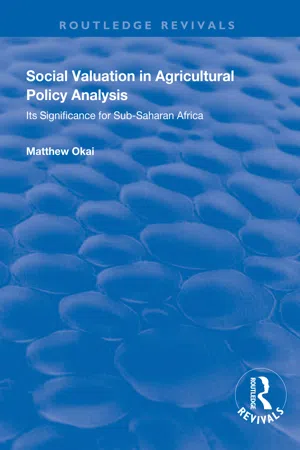Business
Quantitative Demand Analysis
Quantitative demand analysis involves using numerical data and statistical methods to understand and predict consumer demand for a product or service. It focuses on analyzing factors such as price elasticity, market trends, and consumer behavior to make informed decisions about pricing, production, and marketing strategies. This approach helps businesses to quantify and measure demand, enabling them to make data-driven decisions.
Written by Perlego with AI-assistance
Related key terms
1 of 5
4 Key excerpts on "Quantitative Demand Analysis"
- eBook - ePub
Social Valuation in Agricultural Policy Analysis
Its Significance for Sub-Saharan Africa
- Matthew Okai(Author)
- 2019(Publication Date)
- Taylor & Francis(Publisher)
41 ). The horizontal axis is the time in years, while the vertical axis is the tonnage of rice demanded. The projected dotted line is one possible way in which the market in future will behave. The analysis is usually concerned with explaining whether the projection represents a realistic amount of rice that will be consumed in future, represented by years 5 and 6 that lie in the future. The numbers −3, −2, −1, −0 beside lack coordinates for each combination of a year and the quantity of rice consumed each representing a year. The year 0 is the present time.In demand analysis it is recognized that the demand for a commodity is determined by the interaction of many factors apart from its price. The most important of these factors that affect a consumer’s demand include the prices of related goods, consumer’s income, consumer’s tastes and preferences, total population, range of goods available to the consumer, and consumer expectations. When all factors that affect the demand of a commodity are taken together, a demand relationship can be established in quantitative terms. This relationship can be expressed in a functional form as:Trends in consumption of riceFigure 40General market behaviour in response to price changesFigure 41whereX t= f(P x,P n, Y, N, R, E)Xtis the quantity of commodity X demanded; Pxis the price of X; Pnrepresents the prices of related goods; Y represents total consumers income and its distribution; T represents consumers’ tastes and preferences; N is the number of consumers under consideration (population); R represents the range of goods and services available to consumers; and E represents consumers’ expectations. The demand analysis centres around the estimation of the above relationships using various functional forms depending on the specific circumstances and issues under investigation. The most important three variables are: i) the price of the commodity (Px ); ii) the price of related goods (Pn ); iii) population (N) and consumer income (Y).Quantitative Demand Analysis is usually performed through correlation analysis and regression, a technique used in investigating the relationship or association between two variables. In the analysis there are usually two types of variables employed: endogenous and exogenous. An endogenous (dependent) variable, usually denoted as Y, is one whose values are explained by the exogenous (usually denoted by X) variables (independent variables). The exogenous variables are also known as explanatory variables. To investigate the degree to which the demand determinants influence endogenous variables one can apply the concept of elasticity and regression. - eBook - PDF
Successful Dissertations
The Complete Guide for Education, Childhood and Early Childhood Studies Students
- Caron Carter(Author)
- 2018(Publication Date)
- Bloomsbury Academic(Publisher)
Who would benefit from these recommendations? Why should he be cautious with them? What is involved in quantitative analysis? Quantitative analysis in education is the process of presenting and interpreting, in numerical fashion, research participants’ attitudes, views, opinions and/or behaviours. In other words, to examine the distribution of and/or relationships between the variables under investigation: how they are distributed and to what extent and in what ways they are related in a given context (Punch and Oancea, 2014). The primary aim is to identify patterns and regularities in the data (Fielding and Gilbert, 2006). A key issue in quantitative analysis is that the analysis can be undertaken at two distinct levels. The first, and the one that you are most likely to be engaged in as an undergraduate student, is descriptive analysis, or descriptive statistics as it is commonly known. Put simply, this involves the use of appropriate statistical techniques to transform potentially large amounts of numerical data into a form such as tables and/or charts that ‘describe’ your findings in such a way as to make them easy to understand and interpret (Crossman, 2016). The second-level of analysis is what is 212 SUCCESSFUL DISSERTATIONS known as inferential statistics. This is more complex than descriptive statistics and is aimed at drawing conclusions from the data and establishing the extent to which the findings from a sample can be applied to the reference population from which that sample was drawn (Crossman, 2016). Thus descriptive statistics stop at presenting and interpreting data obtained from a sample (a sample of university students, for example), whereas inferential statistics goes a step further: it uses the findings from a sample to make predictions about the reference population (e.g. all the students in a university). - eBook - PDF
- Mohan Munasinghe(Author)
- 2019(Publication Date)
- Routledge(Publisher)
7 Demand Analysis and Forecasting The purpose of this chapter is to provide an introduction to water demand analysis and forecasting, and identify some of the main problems of practical implementation. Accurate demand projections are an important pre-requisite for sound water management, especially for determining future investments in supply capacity. Furthermore, together with the price at which water supplies are set, the level of demand determines the revenue generated by the sale of water to consumers. It is important to look at demand from two perspectives, the first being demand forecasting, and the second being demand management. Demand forecasting is accomplished by a rational assessment of the range of possible demand schedules of consumers for a new, or improved water supply. These will depend on a wide range of factors including current and future population levels, current consumption levels, characteristics of current source and supply, quality and cost of planned service, levels of economic activity, household income, opportunities for water use, etc. Assessment is carried out through consumer survey, water use data collection, and a variety of demand forecasting models and analytical techniques, some of which are described in the following sections. Market research is important to establish willingness-to-pay and demand agendas for different consumer categories. Many of the assessment techniques are contingent valuations which rely on answers to hypothetical questions concerning consumer actions under a range of future supply conditions. Where forecasts are made on the basis of meter readings from existing consumers and projections of past trends, water utilities usually have a quantitative basis for forecasting consumption based on past and present patterns of use under a given price schedule. 232 Water Supply and Environmental Management There are several interrelated reasons underlying the importance of accurate demand projection. - eBook - ePub
The 30 Day MBA
Your Fast Track Guide to Business Success
- Colin Barrow(Author)
- 2019(Publication Date)
- Kogan Page(Publisher)
https://ocw.mit.edu/courses/sloan-school-of-management/15-060-data-models-and-decisions-fall-2014/index.htm ) has a teaching module, ‘Data, Models, and Decisions’, in its first semester that ‘Introduces students to the basic tools in using data to make informed management decisions’. That seems heavy on quantitative analysis, covering probability, decision analysis, basic statistics, regression, simulation, linear and nonlinear optimization, and discrete optimization, but devoid of much qualitative teaching matter. But MIT does use cases, and examples drawn from marketing, finance, operations management, and other management functions, in teaching this subject.Quantitative research and analysis
The purpose of quantitative research and analysis is to provide managers with the analytical tools necessary for making better management decisions. The subject, while not rocket science, requires a reasonable grasp of mathematical concepts. It is certainly one area that many attending business school find challenging. But as figures on their own are often of little help in either understanding the underlying facts or choosing between alternatives, some appreciation of probability, forecasting and statistical concepts is essential. It is an area where, with a modicum of application, an MBA can demonstrate skills that will make them stand out from the crowd.Decision theory
Blaise Pascal (1623–62), the French mathematician and philosopher who with others laid the foundations for the theory of probability, is credited with inaugurating decision theory, or decision making under conditions of uncertainty. Until Pascal’s time, the outcomes of events were considered to be largely in the hands of the gods, but he instigated a method for using mathematical analysis to evaluate the cost and residual value of various alternatives so as to be able to choose the best decision when all the relevant information is not available.Decision trees
Decision trees are a visual as well as valuable way to organize data so as to help make a choice between several options with different chances of occurring and different results if they do occur. Trees (see Figure 11.1
Index pages curate the most relevant extracts from our library of academic textbooks. They’ve been created using an in-house natural language model (NLM), each adding context and meaning to key research topics.



